Stuck on the Bottom
The benthos live on the ocean floor. Starfish, oysters, clams, sea cucumbers, brittle stars and anemone are all benthos. Most benthos feed on food as it floats by or scavenge for food on the ocean floor.
Life at the Bottom
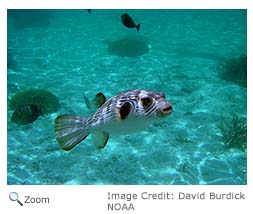 The benthic zone of the ocean is varied. There are mountains, trenches, volcanoes, flat muddy areas, sandy areas and rocky areas. There is a wide variety of life that makes its home on the ocean floor. Some organisms live in the mud, some crawl or swim along the bottom and some anchor themselves to the ocean floor. Life in the benthos region is organized by size. Macrobenthos are organisms that are larger than one millimeter like oysters, starfish, lobsters, sea urchins, shrimp, crabs and coral. Meiobenthos are between one tenth and one millimeter in size. Organisms in this group include diatoms and sea worms. Microbenthos are very tiny organisms like diatoms, ciliates and bacteria. They are smaller than one tenth of a millimeter. The benthic zone of the ocean is varied. There are mountains, trenches, volcanoes, flat muddy areas, sandy areas and rocky areas. There is a wide variety of life that makes its home on the ocean floor. Some organisms live in the mud, some crawl or swim along the bottom and some anchor themselves to the ocean floor. Life in the benthos region is organized by size. Macrobenthos are organisms that are larger than one millimeter like oysters, starfish, lobsters, sea urchins, shrimp, crabs and coral. Meiobenthos are between one tenth and one millimeter in size. Organisms in this group include diatoms and sea worms. Microbenthos are very tiny organisms like diatoms, ciliates and bacteria. They are smaller than one tenth of a millimeter.
Plants On the Bottom
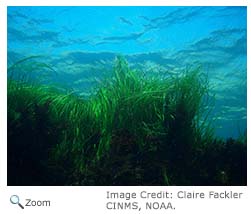 In the Sunlit zone of the ocean there are plants called seagrass. Seagrass isn't seaweed. It is a true plant. It has seeds, flowers, roots and leaves. Most seagrass species are located in silty or sandy soils. Seagrasses need lots of light so they are found in shallow waters. They also need water, if there isn't enough water they will dry out and die. Seagrasses have adapted to life in the ocean. They can live in salt water. Their roots are strong and can withstand waves and ocean currents. Seagrasses take in nutrients and water through their roots and through their leaves. In the Sunlit zone of the ocean there are plants called seagrass. Seagrass isn't seaweed. It is a true plant. It has seeds, flowers, roots and leaves. Most seagrass species are located in silty or sandy soils. Seagrasses need lots of light so they are found in shallow waters. They also need water, if there isn't enough water they will dry out and die. Seagrasses have adapted to life in the ocean. They can live in salt water. Their roots are strong and can withstand waves and ocean currents. Seagrasses take in nutrients and water through their roots and through their leaves.
Not a Plant
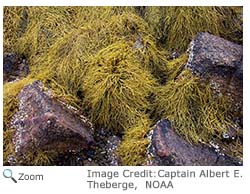 Seaweeds aren't plants. They are algae. Algae are protists. Algae don't have seeds and flowers like plants, they have spores. Algae provide much of the Earth's oxygen. They are the food base for almost all aquatic life. There are three types of algae: red, green and brown. Some algae in the ocean are very small and drift in the ocean water. Those algae are phytoplankton. Seaweeds aren't plants. They are algae. Algae are protists. Algae don't have seeds and flowers like plants, they have spores. Algae provide much of the Earth's oxygen. They are the food base for almost all aquatic life. There are three types of algae: red, green and brown. Some algae in the ocean are very small and drift in the ocean water. Those algae are phytoplankton.
Seaweeds
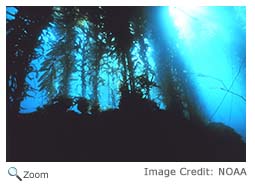 Seaweeds grow in shallow waters where there is sunlight. Most are anchored to the ocean floor or to rocks with holdfasts. Seaweeds are organized into three groups, red, brown and green. Most marine seaweeds are red and brown. Seaweeds grow in shallow waters where there is sunlight. Most are anchored to the ocean floor or to rocks with holdfasts. Seaweeds are organized into three groups, red, brown and green. Most marine seaweeds are red and brown.
Brown Seaweeds
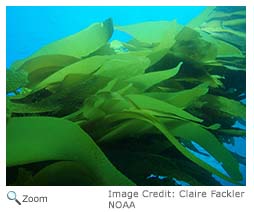 There are over 5,000 species of brown seaweed. Brown seaweed isn't always totally brown. It has a brown pigment called xanthophyll as well as a green pigment called chlorophyll. Because it has both brown and green pigments, brown seaweed can be vary in color from brown to a greenish-brown. Kelp is a brown algae. Some species of kelp can grow 100 feet long. Most species of kelp have stems called stipes that they use to anchor themselves. Gulfweed is another brown algae. Gulfweed has little berry-like pneumatocystson on its leaves that are filled with air and help keep its leaves afloat on the water's surface. There are over 5,000 species of brown seaweed. Brown seaweed isn't always totally brown. It has a brown pigment called xanthophyll as well as a green pigment called chlorophyll. Because it has both brown and green pigments, brown seaweed can be vary in color from brown to a greenish-brown. Kelp is a brown algae. Some species of kelp can grow 100 feet long. Most species of kelp have stems called stipes that they use to anchor themselves. Gulfweed is another brown algae. Gulfweed has little berry-like pneumatocystson on its leaves that are filled with air and help keep its leaves afloat on the water's surface.
Seeing Red
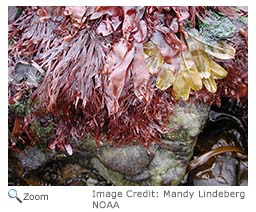 There are over 2,000 species of red algae seaweeds and they are usually small. They are most common in temperate and tropical waters. Their red color comes from the pigment phycoerythrin. Phycoerythrin helps red algae photosynthesize in dim light. Because they can use dimmer light, they often grow in deeper waters than other algae. There are over 2,000 species of red algae seaweeds and they are usually small. They are most common in temperate and tropical waters. Their red color comes from the pigment phycoerythrin. Phycoerythrin helps red algae photosynthesize in dim light. Because they can use dimmer light, they often grow in deeper waters than other algae.
|
|
It's Not Easy Being Green
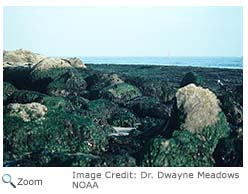 Green algae are more common on land and in freshwater environments. They get their color from chlorophyll. They aren't as common in the ocean as brown and red algae seaweed. There are about 800 different of green marine seaweeds. Sealettuce or ulva is a common green algae seaweed that can be found in rocky and sandy pools. Green algae are more common on land and in freshwater environments. They get their color from chlorophyll. They aren't as common in the ocean as brown and red algae seaweed. There are about 800 different of green marine seaweeds. Sealettuce or ulva is a common green algae seaweed that can be found in rocky and sandy pools.
A Star Is Born
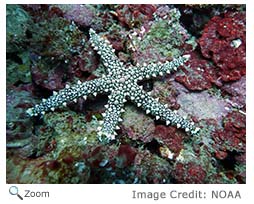 Starfish aren't fish. They are invertebrates. They have no bones. There are around 1,800 species of starfish, and they live in all of the world's oceans. Starfish usually have five arms. Their arms are hollow and usually covered in spines on the top. On the underside, most starfish have little tube feet with suction cups on the ends that they use to move and to grab onto things. If a starfish loses an arm, another one will grow in its place. The starfish's stomach is on its underside. Some starfish can grab a clam or other mollusk and pry its shell open. Some species push their stomachs out and surround their prey, digest it an then pull their stomachs back in!
Sea Urchins
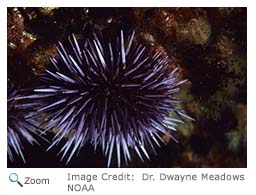 Sea urchins are related to starfish and like starfish they are divided into five parts and covered with spines. On some species the spines are venomous. Sea urchins have little tube feet with suckers on the end that they can use to move around. Their stomachs are on their underside and they have a hole on top that they use to get rid of waste. Most of their diet is made up of algae. Sea urchins live on the ocean floor, usually on hard surfaces like rocks or coral. There are about 700 species of sea urchins.
Flowers of the Sea
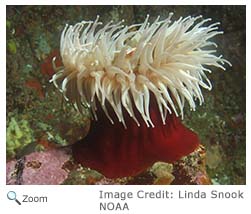 Sea anemone are invertebrates like starfish and sea urchins. There are about 1,000 species. They can be found at depths of up to 30,000 feet. They are found in all the world's oceans. Some of the most colorful ones are found in tropical waters. Sea anemone are invertebrates like starfish and sea urchins. There are about 1,000 species. They can be found at depths of up to 30,000 feet. They are found in all the world's oceans. Some of the most colorful ones are found in tropical waters.
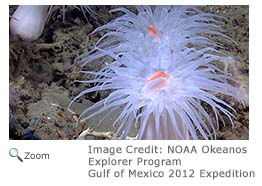 Sea anemone come in a wide range of shapes and sizes. They can range in size from a less than an inch to five feet in diameter. They have a mouth in the center of their body. Their mouths are usually surrounded by petal-like tentacles. They use the tentacles to catch food. The tentacles may have venomous stingers on them that paralyze prey. They then pull the prey into their mouths with their tentacles. Most species attach themselves to rocks, the ocean floor and sometimes animals with their pedal disc. The pedal disc on the bottom of the sea anemone is like a suction cup! Most sea anemone are stationary, but some can creep along very, very slowly using their pedal disc. There are some species that bury all but their tentacles and mouths under the sand or silt and a few species float in the water. Sea anemone come in a wide range of shapes and sizes. They can range in size from a less than an inch to five feet in diameter. They have a mouth in the center of their body. Their mouths are usually surrounded by petal-like tentacles. They use the tentacles to catch food. The tentacles may have venomous stingers on them that paralyze prey. They then pull the prey into their mouths with their tentacles. Most species attach themselves to rocks, the ocean floor and sometimes animals with their pedal disc. The pedal disc on the bottom of the sea anemone is like a suction cup! Most sea anemone are stationary, but some can creep along very, very slowly using their pedal disc. There are some species that bury all but their tentacles and mouths under the sand or silt and a few species float in the water.
Armed and Ready
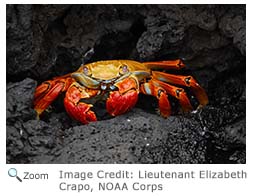 Crabs are crustaceans. They have outer shells or exoskeletons that protect them from predators, ocean currents and waves. There about 4,500 species of crabs and they are found in fresh and salt water. Crabs have tails, but they are tucked under their bellies. Like fish, crabs have gills that they use for breathing. Most crabs move by crawling along the ocean floor, although there are some species that swim. They have large front pincers that they use to find and catch prey like clams, small fish, snails and other crabs. They may also use their pincers to smash open shells. Crabs usually wait for food to go by. They may sift through the sand or silt with their legs and antennae. They may also find food with their antenna.
|